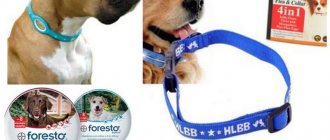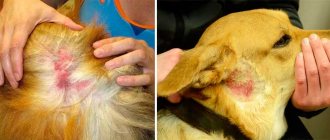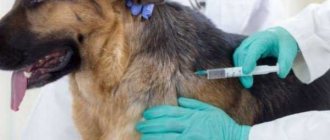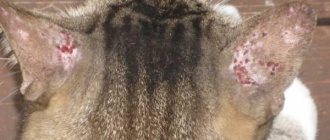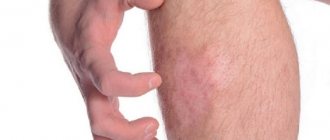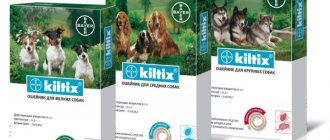Allergy is the body's hypersensitivity to antigens. The disease manifests itself when an allergen penetrates into the blood through the mucous membranes, skin or respiratory system.
Allergies can develop in humans and any animal, including dogs. Pets often suffer from dermatitis caused by a flea bite. The saliva of parasites contains substances that provoke hypersensitivity reactions.
These include rash, swelling, sneezing, watery eyes, or itchy skin.
Failure to treat these symptoms often leads to the development of more dangerous skin diseases. Sometimes the animal dies due to anaphylaxis, cardiac or respiratory failure.
Therefore, when an allergy appears, it is important to immediately get rid of fleas and carry out comprehensive anti-allergy therapy.
Symptoms and behavior of animals
Manifestations of flea allergy can be noticed by the rapidly changing behavior and condition of the pet. Symptoms of flea dermatitis in dogs:
- Severe itching. The dog itches continuously, which leads to redness of the skin and the appearance of abrasions and open wounds on it.
- Dandruff. Small white flakes can be seen on the fur.
- Unpleasant odor emanating from the body and mouth.
- Lack of appetite.
- Digestive system disorders: frequent constipation or prolonged diarrhea, nausea and vomiting.
- Formation of edema on the mucous membranes.
- Dryness and flaking of the skin.
The pet's behavior changes radically: it becomes lethargic, refuses to go out, ears droop, and constantly wags its head.
Self-diagnosis
The owner can determine the presence of an allergic reaction to parasites in a dog independently through a thorough examination. Fleas choose to settle on the rump, stomach, root of the tail and inner thighs. When an allergy develops, the animal begins to intensively scratch these areas. Having parted the fur, the owner will find a large number of fleas and nits. The latter are not difficult to identify: they look like a small black dot and can be easily removed from the animal’s fur with your fingers. Female fleas, engorged with blood, are brown in color and have a large body.
The combination of a large number of parasites, constant itching in the animal and the presence of inflammatory foci with purulent contents on the body indicate that the dog is allergic to flea bites.
There are situations when a dog has only a few parasites on its body; the rest hide in carpets and upholstered furniture, periodically attacking the animal. Even if the owner has no doubt that the pet is allergic to flea bites, before starting treatment, it is necessary to show the animal to a veterinarian to clarify the diagnosis.
Larvae
The larvae appear 14 days after the flea lays its eggs. A person will not be able to notice them, since they are very small in size.
What does a flea larva look like:
- small size – 0.5-1 mm;
- white.
Newly hatched larvae avoid sunlight. They feed on waste from other fleas, particles of human and animal skin. They can be confused with fly larvae, since the slightly grown ones resemble worms.
They develop after hatching from the egg for about 20 days. They have to go through several stages of pupation before they develop into real fleas. After three weeks, they can already mate and leave offspring.
It is extremely rare to find a larva on an animal's fur. This only happens when the dog's body is oversaturated with these parasites. The photo below shows flea larvae.
How dangerous are flea bites for humans?
Parasites are able to coexist with a person in his home for years. In addition to painful bites and unpleasant red spots, fleas can transmit dangerous infectious diseases. Their treatment can take a lot of time and a large amount of money. Here is a list of the most dangerous viruses ever carried by fleas:
- Typhus : the infected person has a high fever, vomiting, and aches.
- Brucellosis : the disease seriously affects the human nervous system, the temperature rises. Often the disease develops into more acute forms. This leads to arthritis and disruption of the reproductive system.
- Anthrax : the patient's body becomes covered with non-healing ulcers. The infection affects internal organs and is fatal.
They say that fleas can carry the pathogens of dermatitis , hepatitis and encephalitis . An attack by parasites can trigger allergies .
Frequent flea bites have a detrimental effect on the nervous system . Because of this, constant phantom pain occurs. At this moment the person feels a sharp prick, but the bite mark does not appear. Some people even start to itch their entire body at the mere thought of insects. In this case, only complete disposal of parasites using specialized means and sedatives will help.
Danger and possible consequences
Allergies in dogs require immediate treatment, since the disease can cause a number of complications and serious consequences. Intensive scratching of the skin leads to the appearance of open wounds, in which a favorable environment is created for the development of pathogenic microflora that comes from the outside or is brought in by the parasites themselves. This leads to the appearance of purulent-inflammatory processes that provoke severe intoxication of the animal.
Late treatment of allergies can lead to dermatitis becoming chronic with frequent outbreaks of relapses. A weakened animal’s body and a depressed immune system can lead to consequences such as heart or respiratory failure. Untreated parasite allergies often lead to the death of dogs.
Formation of wounds due to flea bites.
Main symptoms
Flea allergy is a pathology that occurs quite often. This is a reaction to allergens present in the saliva of insects. The main features of this type are:
The environment also often causes allergies in living beings. These are flowers, fibers of natural materials, mold, dust mites. If the allergen is always in the house, then the pet’s reaction will be constant. In other cases, the disease manifests itself seasonally.
There are two types of environmental allergies:
- Atopy is a hereditary tendency to allergies to the external environment. This is the most common type. Mostly seasonal atopic dermatitis is observed. Seborrhea and dry skin appear.
- Contact allergy. Formed due to the interaction of a dog with an object where the allergen is located. Usually seen on the paws, face, and stomach lining.
Important afterword
As you may have noticed, in the article we did not indicate a single name of the drug and did not offer a replacement for an unsuccessful purchase, which dog breeders love to ask on thematic forums.
The fact is that every dog, every body is individual and what suits one dog may quite possibly cause an allergy in another. Therefore, we highly recommend that you do not throw away the packaging of the collar until you are absolutely sure that it does not cause allergies in your dog. Otherwise, you should immediately contact a veterinarian so that he can help you select medications for treatment and then suggest another product for parasites, based on the composition of the unsuitable product.
Features of the course of allergies
The reaction to flea saliva in dogs is related to the season of the year. Most often, an allergy outbreak occurs in spring and summer. Signs may appear immediately after the bite or be sluggish, it all depends on the degree of sensitivity of the body. But in most cases, reactions occur due to numerous bites and prolonged presence of parasites on the animal’s body.
The first sign is itching, which can last from several hours to 2 days. Other symptoms:
- deterioration of skin condition;
- changes in general condition and behavior: appear after several weeks or months, depending on how sensitive the animal’s skin is.
In order to detect the disease in time and prevent the condition from worsening, you need to immediately respond to the appearance of prolonged itching in your pet. Timely examination and provision of veterinary care will help save the dog not only health, but also life.
Mechanism of infection
Did you know that, according to numerous testimonies from veterinarians, in 90% of cases, the majority of skin lesions in their patients are caused by representatives of the blood-sucking order? For some reason, many owners zealously deny the presence of fleas on their four-legged pets, which causes bewilderment among experienced specialists. Owners of small dogs, who “relieve themselves” in a litter box at home, like cats, especially suffer from this misconception. In their opinion, if a pet practically never appears on the street, then this unpleasant problem has nowhere to come from. It's time to dispel dangerous misconceptions.
The flea is a hematophagous insect and, as you probably know, they feed not only on the blood of animals, but also on people. Sensitive tiny insects are able to penetrate apartments and houses:
- from the street;
- from the entrance;
- through windows and cracks.
For the most part, you don't have to be the owner of a furry friend to attract a flea's attention. Without even meaning to, you yourself bring a parasite into your home, for example, on your clothes or dirty shoes.
As a rule, blood-sucking insects hide:
- in sofas;
- mattresses;
- in dust;
- under the parquet;
- in tile cracks;
- behind the baseboards;
- behind the wallpaper and in other secluded corners.
Almost the entire population of tiny bloodsuckers consists of larvae. For a whole year they exist unnoticed in human homes, waiting for their finest hour. And although the main period of outrage of insatiable creatures is considered to be spring, summer and autumn, it is the long stay in the pronymph (pupa) stage that makes these insects very viable and increases the likelihood of flea infestation even in winter.
As you have already understood: fleas are extremely tenacious and dexterous creatures. If a doctor suspects a tailed couch potato is infected with parasites, do not be reckless and deny the diagnosis.
Which breeds are more susceptible
Flea dermatitis can occur in any dog, without exception, regardless of gender, age, or breed. The severity of the disease depends on the individual characteristics of the body, the rate of progression and the severity of the allergic reaction.
Dermatitis caused by flea bites is most often diagnosed in representatives of short-haired breeds - dachshunds, Labradors, bulldogs, boxers, Rottweilers, German shepherds.
Short description
Fleas are wingless blood-sucking insects, covered with a protective, keratinized shell , having a body shape flattened on both sides. Currently, there are more than 2,300 varieties of fleas, but all insects that parasitize animals lead the same lifestyle, therefore, the methods of fighting them are the same .
Flea bites, unfortunately, affect not only animals on which parasitic insects live. A person is also susceptible to bites , which can cause a severe allergic reaction or dermatitis. If an infected animal lives in the house, then the nights can turn into hell not only for the animal but also for the person.
Actions for anaphylactic shock
A large accumulation of parasites on the body and numerous bites can provoke anaphylactic shock, leading to the death of the animal without proper assistance. In this condition, the dog must be urgently taken to a veterinary clinic. If you can’t do this quickly, you can save your pet’s life by providing the correct first aid:
- If the dog is conscious and able to swallow, it should be given an antihistamine. The medicine will help reduce the intensity of symptoms.
- Breathing is accompanied by gurgling sounds - a sign that the lungs are filling with fluid. If the animal is conscious, it must be taken by the hind legs and lifted, holding in this position for 10 seconds.
- The dog is not breathing - artificial respiration is required. The pet should close its mouth and inhale air quickly and rhythmically 2 times into its nose. In 1 minute you need to take 15 to 20 breaths into the nose until the animal begins to breathe on its own.
Anaphylactic shock in a dog. After all the manipulations have been completed, take the pet to the hospital. At the veterinary clinic, the animal is administered anti-shock and potent antihistamines, and symptomatic therapy is provided if necessary.
Prevention
It is quite simple to protect your pet from infection by insects of any kind, if you do not forget to carry out regular preventive treatment of the dog and the room in which it is kept.
Specific actions for prevention:
- Processing with special means . Use flea shampoo regularly when bathing. Once a month, apply drops or spray, or wear a special collar.
- Limiting contact with homeless people and obviously infected animals. Choose places for walking away from possible breeding grounds, which are trash cans and places where dogs constantly gather.
- Weekly wet cleaning of the house and monthly special treatment against parasites . Fleas often only feed on the host; they prefer to live and reproduce in more secluded places. Therefore, treatment with insect repellent compounds is carried out regularly. At home, a solution of vinegar or citrus fruits in water is perfect for this.
- When accepting a gift of another animal's belongings, find out whether the animal has ever been sick. In any case, subject them to heat or special treatment, since flea eggs may not be visible to the naked eye.
Regular high-quality prevention will protect your pet and family from parasites and significantly reduce the risk of contracting many diseases carried by fleas.
How to remove fleas from a dog at home
There are many effective remedies to help rid your pet of fleas on your own. To choose the right drug, you need to consult a veterinarian. Many types of pharmaceuticals have contraindications for treating sick, old, pregnant animals and puppies.
Shampoos
Flea shampoos are the safest remedy for pests. They have a mild effect, rarely cause side effects and can be used to treat weakened dogs and puppies. At the same time, shampoos have a caring effect on the dog’s coat.
The drug is diluted in water until foam forms and the pet is dipped into it. After water procedures, the animal is combed and dried. Insects immediately leave the animal or die on it.
However, using such a product is not easy, because it is not always possible to bathe a dog with ease. In addition, the effect does not last long, which is why you have to constantly use the drug. The most effective brands of shampoos are Bars, Celandine, Rolf Club, Beafar, Dana, etc.
One of the popular means of fighting parasites at home is dog shampoo.
Drops
This form of the product is more convenient to use. The drops contain insecticides phenothrin, imidaclopid, permethrin and other types that have a nerve-paralytic effect on pests. They are dripped onto the withers and along the spine, after which they are rubbed into the skin.
The toxic substance begins to accumulate in the epithelium, but it does not penetrate into the bloodstream.
The effect of using drops lasts 2-3 months. Most of the parasites die in a short time, the rest leaves the animal. When used correctly, adverse reactions of the body are extremely rare. However, almost all drops are prohibited for puppies under 2-3 months and lactating bitches.
The most effective remedy is Bars Forte.
Drops will help disinfect.
Collars
Insecticidal collars are easy to use and safe. They are biological and chemical. The first products contain exclusively natural substances, so the body is not exposed to toxic effects.
The effect of a dog flea collar lasts for several months.
However, chemical collars are also considered safe, since the daily dosage of the toxic substance is calculated in such a way that it destroys pests and does not affect dogs.
The disadvantages of such an item include a limited area of impact - the neck. In addition, it should not be used simultaneously with other insecticides, such as drops.
The most popular brands of collars are Four with a tail, Celandine, Beaphar.
Insecticidal sprays
These products contain repellents and insecticides, which cause rapid death of fleas - all parasites are destroyed within 24 hours. The drugs are considered toxic and problematic to use . Before applying the spray, you must wear rubber gloves. In this case, the stream should not hit the animal’s face.
Popular flea sprays.
In addition, the dog should not be allowed to lick its fur for 2-3 hours, as side effects such as difficulty breathing and vomiting may develop.
To cure an animal, the spray should be sprayed onto its skin, not its fur. The toxic substance accumulates in the sebaceous glands, epidermis, and hair follicles.
To avoid licking off the drug, use a cervical collar. For 2 days after treatment, you should not wet your pet or allow it to come into contact with other dogs. The most effective sprays are Frontline, Hartz, Bars Forte.
Pills
The tablets contain fluralaner and afoxolaner. Such components belong to a new class of isoxazolines, and they destroy a large number of different pests. The tablets do not cause the development of negative reactions in the body and are safe for puppies and sick dogs.
Popular drugs: Bravecto, Comfortis, Frontline Nexgard.
Powder
Insectoacaricide powders are the cheapest and safest product. They are made from butox.
Before using the product, it is necessary to conduct several tests on the animal’s skin and assess its condition.
This method of treatment provides for a long therapeutic course - about 2 weeks. The most commonly used are Barrier, Insectal, Sanal.
Powder for killing fleas on dogs.
Allergy treatment
Treatment methods are selected depending on the severity of the symptomatic picture. But the first thing the owner needs to do is rid the animal of parasites using special shampoos and drops. In addition to cleaning the dog's skin and fur from fleas, it is recommended to disinfect all furniture in the house, carpets and bedding that may contain them.
A diet is required. When feeding a dog with ready-made commercial diets, it must be switched to hypoallergenic food. If the pet is on a natural diet, the veterinarian selects the menu for her.
Drug therapy
When treating flea dermatitis, antihistamines are necessarily prescribed to inhibit the effect of the hormone histamine and relieve the signs of pathology. The following drugs are used in therapy:
- Diphenhydramine. The drug eliminates inflammation and relieves allergic reactions.
- Cyprodine. This is an oral medicine. Cyprodine eliminates fever and relieves severe itching.
- Diprazine. Release form: tablets and solution for intramuscular administration.
- Astemizole. The medicine should not be given to pregnant dogs.
If the allergy is advanced and antihistamines do not give a positive result, the animal is prescribed glucocorticosteroids. To restore the body depleted by allergies, vitamin complexes, immunomodulators and supporting drugs that contain iron are used.
Folk methods of struggle
Along with taking medications, traditional methods of therapy can be used in the treatment of flea dermatitis. To speed up the healing process of the skin and relieve itching, it is recommended to treat the affected areas of the skin with decoctions based on medicinal herbs: chamomile, calendula, coltsfoot, comfrey and sage.
All decoctions are prepared according to the same recipe:
- 1 tbsp. l. the selected herb is poured with a glass of boiling water.
- The liquid is infused until it cools completely, after which it is filtered.
- A cotton pad is moistened with the decoction. They treat the skin carefully, without pressing too hard.
Aloe heals skin well. It is recommended to grind the cut leaf of the plant into a paste and apply it to the skin for 30 minutes. Since aloe has a pronounced laxative effect, it can be used in areas where the dog cannot reach with its tongue.
Aloe juice purchased at a pharmacy can be added a few drops to your pet’s food. This will help improve digestion and strengthen the immune system so that the body can independently resist allergens, thereby reducing the intensity of symptoms of the disease.
Echinacea is another effective remedy for treating flea dermatitis in dogs. Gauze, folded several times, should be moistened in it and applied to the damaged area. Keep the compress for up to 30 minutes.
It is important to remember that traditional methods cannot be used as the only method of treating flea allergies in dogs. Such treatment is only an addition to the main drug therapy.
